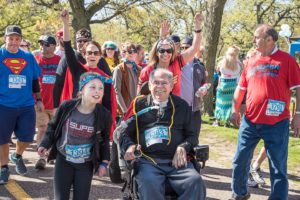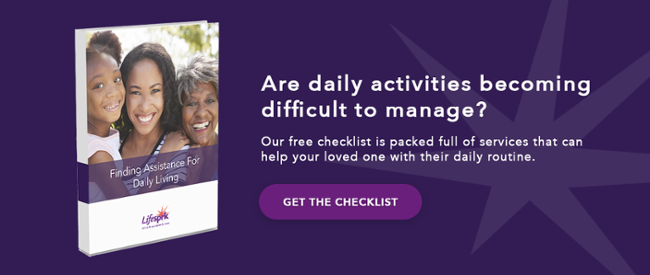Bob Horeck’s story is one of hope and understanding. He wants those battling ALS to know this: ALS doesn’t have to stop you from living – and you can go home again even with a ventilator.
Bob spent most of his life as a business owner and entrepreneur creating complex solutions for complicated problems. Retirement was meant to be spent actively with his wife, Cheryl, and their busy family along with frequent travel, playing hockey and tinkering around the house and cabin. These are the things that gave his life purpose. These were supposed to be the Golden Years of senior life and his legacy filled with stories, joy in leading others, and teaching by example would grow deeper by the campfire. But over three years ago at the age of 67, that dream required some unexpected shifting as Bob was diagnosed with ALS, or amyotrophic lateral sclerosis, a progressive neurodegenerative disease that affects nerve cells in the brain and the spinal cord.
Over the next year Bob, Cheryl and their five children adjusted their lives and educated themselves on what it means to live with ALS while connecting with the ALS community through support groups. In September 2016 Bob experienced respiratory decline landing him in the hospital requiring a tracheostomy and feeding tube. He was previously resistant to allowing a tracheostomy, assuming it meant becoming ‘a vegetable.’ Left with little option other than rapid decline, he agreed, and found that the procedure was straight-forward and done in his hospital bed. The result far exceeded expectations. Two days later, he was transferred to a long- term rehabilitation hospital to recover and adjust to a ‘new normal.’ Bob had to relearn how to use his voice, fuel his body, and navigate the next steps to reach his goal of going home.
Recovering with home care: creating a new normal
When Lifesprk, a whole person senior care company, met Bob and his family, it was, according to his daughter, Janet, the worst stage of his ALS. After the surgery Bob and his family were faced with an even bigger challenge: the need for 24-hour nursing. There are only two facilities in the Minnesota Twin Cities area capable of caring for clients who need a ventilator and 24/7 care.
Once connected with Lifesprk, Bob was able to return home where he wanted to be. Lifesprk was able to staff his round-the-clock care with private-pay nurses and the added benefit of the Life Care Manager role at their home. Creating these solutions was not without challenge. For Lifesprk, it was staffing enough nurses who were trained on tracheostomy care and formulating a schedule that worked for everyone. For Cheryl, it was adjusting to sharing the caregiving role, tolerating strangers coming and going all day, while navigating medications, storage of supplies, and billing. For Bob, it was accepting the fact that he needed help doing everything, and knowing that he needed to learn all facets of his care to orient new nurses to his care preferences.
In the first month, they tried settling into a new routine. A couple trips back to the hospital resulted in new procedures and equipment added into the care process. Lifesprk was with Bob and Cheryl frequently to make sure their team was prepared and educated on new needs to prevent additional hospital visits. Kris Teigen, RN, Life Care Manager for Lifesprk was instrumental in guiding the family, and coordinating information between the hospital team and Lifesprk to make a smooth transition home.
Days were consumed with cares and treatments leaving very little free time. Over the course of the next six months, Lifesprk integrated physical therapy, occupational therapy and several primary nurses for consistency. Heidi Ashfeld, LPN, Heidi Howard, RN, and Kepha Maangi, LPN, Lifesprk private-duty nurses, were instrumental in working to establish a more efficient and flexible program. It gave Bob and Cheryl time to enjoy together, as well as time for family visits and outings that brought the spark back to their lives. Bob and Cheryl wanted to have a meaningful active life in spite of the effects of ALS.
Bob finds his spark in spite of the effects of ALS
Early on, Caitlin Scott, Lifesprk Physical Therapist and Jill Fuller, Lifesprk Occupational Therapist Assistant, determined there was a possibility for Bob to recover a good portion of his muscles that had atrophied but had not yet succumbed to ALS. “Maximizing what I’ve got has been paramount to me since the beginning of my diagnosis,” said Bob. As a team, Bob and Lifesprk dedicated themselves to pushing his strength and range of motion to the extent that his ALS would allow. Prior to working with Lifesprk’s therapy team, Bob said, “I didn’t know what I had left and was surprised to find how much room for improvement I have.” Caitlin added, “Bob drives his own therapy, which is uncommon and very rewarding. He is so inspiring and determined. He pushes me to be a better therapist, and himself to be a harder worker every day. We have discovered new tools and methods together and are working now for the first time with a sling (think rehab version of the Johnny Jump-Up) to increase balance, strength, and range of motion.”
 High on Bob’s wish list was to participate in the ALS Superhero Dash. It’s something he looked forward to each year as he watched from the sidelines while ‘Team Bob’s Entourage’ ran or walked. He missed being present for the 2016 fall race and instead watched via FaceTime from his hospital bed. May 2017 marked the fourth year Bob’s team participated in this event but this one was different. Bob was going to hang up his spectator hat for a race number.
High on Bob’s wish list was to participate in the ALS Superhero Dash. It’s something he looked forward to each year as he watched from the sidelines while ‘Team Bob’s Entourage’ ran or walked. He missed being present for the 2016 fall race and instead watched via FaceTime from his hospital bed. May 2017 marked the fourth year Bob’s team participated in this event but this one was different. Bob was going to hang up his spectator hat for a race number.
To coordinate all of the elements needed to support the outing and a 5k trek by wheelchair around the course (roughly comparable to the prep needed to climb a portion of Mt. Everest), the Lifesprk team and Bob timed his daily treatments around the outing, set up an adequate supply of liquid oxygen, loaded the emergency bag to accommodate any complications and made sure it could all be stowed on the wheel chair for mobility. Bob and Kepha made a dry run to ensure that the battery and wheel chair could make the distance and that the course condition was manageable. “I wasn’t sure I could walk that far,” said Kepha. “During the dry run, we limited the pace the wheelchair was allowed to go.” The trial run was very enjoyable and completed in a time of 1:36. On race day, ‘Bob’s Entourage’ had a great turn out. Kepha and Bob led the team completing the race in 1:04. Bob’s smile says it all.
As Bob says, this is a story of hope and understanding that ALS doesn’t have to stop you from living. The proof of this lies in what he’s been able to accomplish with his support circle sparking the way. But the real measure of his successful collaboration with Lifesprk was reflected in the routine 3-month ALS clinic appointment which assesses his current condition and anticipates upcoming needs. At Bob’s last appointment, the doctor said that things were going so well there was no need for a recheck for another six months. The family was elated. When Caitlin learned this news it gave her goosebumps. “At this stage of the disease, that’s unheard of,” she explained. “Clients like Bob remind me why I went into healthcare.”
Why Bob’s ALS story is important
Bob’s story is important for so many reasons. He wanted to do the walk and despite so many health challenges he did it anyway. He is in a wheelchair and yet he pushes himself further each day. Bob and Cheryl are, by nature, proactive and positive. Over time some control of his body is declining yet he still has reasons to wake up each morning with a renewed sense of optimism, maybe it’s enhanced by the care he is receiving, one that infuses compassion with care.
Heidi believes it’s the Lifesprk philosophy that goes beyond just care at home. “Our goal when Bob became our client was never just about maintaining the progression of his disease. It was about giving him his and Cheryl’s life back. That’s where the success comes from – the approach.” Perhaps trusting that Bob knows his body better than anyone else is also a piece of it. “If he feels comfortable skipping a treatment to go out for lunch and enjoy the afternoon, then that is his decision. If he wants to do a 5k that seems impossible, we will figure it out and do it,” added Heidi. “He shouldn’t have to sit back and watch life pass by because he has ALS so we do what we can to support those goals.”
Cheryl stressed “I am so proud of my husband. He has never failed to impress me since the day I met him. He is a loving, caring, positive person.”
What’s next for Bob and Cheryl? They are anxious to visit more outdoor parks and get more fresh air with his nurses. The health benefits are instantly measurable and he can enjoy life so much more now than before. And of course, look forward to the next ALS walk – who knows, perhaps they’ll beat this year’s record.



